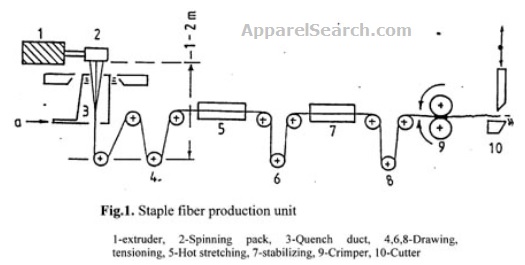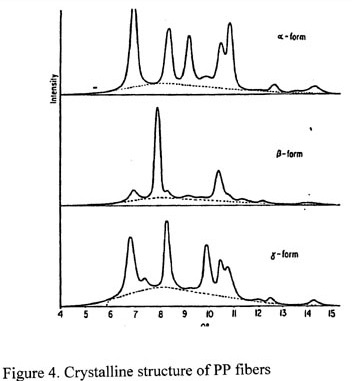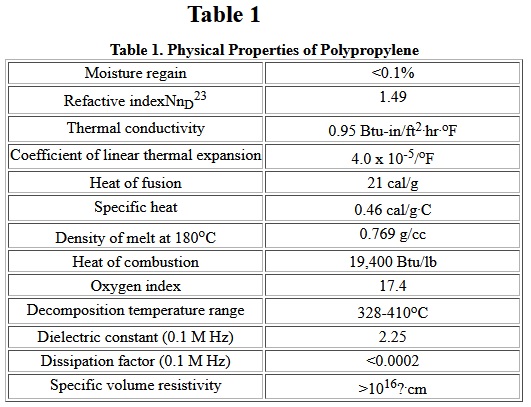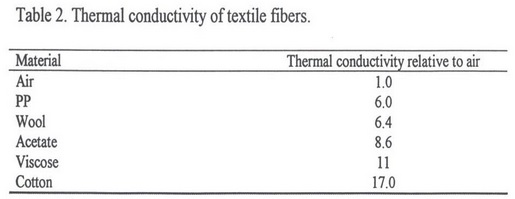OLEFIN fiber Educational Research presented by Apparel Search for the textile industry
Haoming Rong & Monika Kannadaguli
Olefin fiber is a manufactured fiber in which the fiber-forming substance is any long-chain synthetic polymer composed of at least 85% by weight of ethylene, propylene, or other olefin units. Olefin fiber is a generic description that covers thermoplastic Fibers derived from olefins, predominately aliphatic hydrocarbons. Olefins are products of the polymerization of propylene and ethylene gases. Polypropylene (PP) and polyethylene (PE) are the two most common members of the family.
Polypropylene is extremely versatile as a fiber-forming
material, whereas polyethylene is not as good a fiber-forming high polymer
material. Since its introduction into the textile industry in the 1950s, the
list of successful products and markets for polypropylene fiber has
increased exponentially. Figure 1 shows the increase of producers
shipments
of olefin staple to nonwovens in the US from 1989-1998[1].
Figure 1: source: fiber Economics Bureau
![]()
Of the polypropylene used in the U.S., more than one-third goes into fiber and fiber-related products. The declining price and continuing improvements in the quality of polypropylene resins, plus the low specific gravity of the polymer (which provides high covering power), have been important factors in the development of new product end uses.
Production Technology for Polyolefins
A. High-Pressure Processes for Branched LDPE
- Autoclave reactor process
- Tubular reactor process
B. Polymerization Processes for Linear HDPE, MDPE, LLDPE and Copolymers
- High-pressure autoclave reactor
- Low-pressure liquid slurry processes
- Low and medium pressure solution processes
- Low pressure gas phase processes
C. Polymerization Processes for PP and Propylene Copolymers
All the above processes have been used in the production of PP. The special process
technologies for PP and propylene copolymers include two kinds of liquid pool slurry
process:
- Low pressure liquid pool slurry phase processes
- Low pressure modular gas phase reactory
D. Polymerization Processes for other Polyolefins
- Slurry phase heavy-diluent stirred-tank reactor
- Slurry phase light-diluent stirred-tank reactor
- Tubular high-pressure process
- Solution phase medium-pressure adiabatic reactor
Processing Methods for Polyolefins
There are six important processing methods for polyolefins, these are:
- Injection molding
- Rotational molding
- Blow molding
- Extrusion
- Blown film extrusion
- Cast film extrusion
Processability of Polypropylene
A major virtue of polypropylene is its ability to be used in a wide range of fibrous forms[2]. Fibrous forms of polypropylene include staple, bicomponent staple, monofilament, multifilament, slit film yarns, slit-fibrillated film yarns, spunbonds, melt blown nonwovens, synthetic pulps, and extruded nettings. It can be made into ropes and cordage, primary and secondary carpet backing, carpet face yarns, upholstery fabrics, geotextiles, filtration materials, horticulture/agriculture materials, automotive fabrics, spill-cleanup materials, disposable diapers, hospital/medical care materials, and protective clothing.
The melting point of polypropylene (160-170
C) is an
advantage in many nonwovens processing steps. PP fiber can be softened
sufficiently to bond to one another without destroying fiber properties.
Nonwoven Fibers made from polypropylene can therefore be fusion-bonded,
eliminating the need for chemical binders. The benefits of this technique
include both energy saving and environmentally friendliness. Uses of
thermally bonded cover stock in baby diapers and similar products will
result in a markedly increased use of polypropylene. The fusion
characteristics of polypropylene are used not only to bond carded webs but
also to improve the dimensional stability of needle bonded fabrics. A large
amount of engineered fabrics for road stabilization, dam and lake
reinforcement, soil stabilization and roofing are made from polypropylene
Fibers. Melt-blown fabrics are widely used in filtration media, battery
separators, etc.
The relatively high melting point allows PP nonwovens to
be used up to the temperature of 120
C before softening occurs. The soft
hand and hydrophobic properties make PP nonwovens particularly suitable for
hygiene products, baby diapers and adult incontinents. Spunbond and
meltblown are the two main processes for polypropylene nonwoven fabrication.
Both techniques require PP resins with high melting flow rate and relatively
very narrow molecular weight distribution. The Fibers produced in spunbonded
nonwovens are spun filaments, whose diameters are in the range of 10-35
microns, whereas the Fibers of meltblown nonwovens are usually discontinuous
and much finer, typically less than 10 microns. This partially explains why
meltblown webs are usually weaker than spunbonded webs.
Processability of a polymer is highly dependent on its rheological properties, which have close relationship with its molecular weight, molecular weight distribution, temperature and shear rate. PP resins are generally categorized according to their melt flow rates ( MFR), which is the amount of material that passes through a standard die hole for ten minutes. Polymers with higher molecular weight have lower MFR and higher viscosity (under a given temperature). Commercial polypropylene has a wide range of MFR from 0.25 to 800. MFR is a very important parameter for both melt-blown and spunbond processing. PP melts exhibit non-Newtonian viscosity, normal stress in shear flow, excessive entrance and exit pressure drop, die swell, melt fracture and draw resonance. PP melts are more viscoelastic than PET and nylon melts. The flow pattern and stability of PP melts are highly dependent on the shear rate. Above the critical shear rate, melt fracture may occur.
Processability of polypropylene fiber is also influenced by the die geometry. The L/d ratio has to be optimized to reduce instability and the effects of PP's high viscosity. Both melt fracture and draw resonance represent instabilities in flow. Draw resonance is a periodic variation in diameter of a spinning threadline above a critical draw-down ratio. Slowing down the drawing operation or a suitable cooling procedure may prevent this.
In addition, processability of polypropylene fiber can also be affected by other factors such as finishing. Finish oil is a mixture of several chemicals that function as anti-static agent and lubricator to protect the filament. The results of the effects of finishing on this area are not available in this report yet.
Since unmodified polypropylene is not dyeable, pigmentation has become the preferred way of coloration in textile and textile-related applications. Generally, the fastness properties of pigmented Fibers are superior to those of dyed Fibers. Pigmented polypropylene Fibers have become established for contract carpets, indoor/outdoor carpeting, synthetic turf, and other applications, in part because of their superior fastness properties. Light stabilizers have helped to open new markets for products intended for use outdoors, and improved heat stabilizers have boosted extrusion efficiency and allowed use of more recycled material.
Characteristics of Olefin Fibers
- Good bulk and cover, very lightweight (olefin Fibers have the lowest specific gravity of all Fibers)
- High strength( wet or dry)
- Resistant to deterioration from chemicals, mildew, insects, perspiration, rot and weather
- Abrasion resistant
- Low moisture absorption
- Stain and soil resistant
- Lowest static component of any man-made fiber
- Sunlight resistant
- Good washability, quick drying, unique wicking
- Resilient, moldable, very comfortable
- Thermally bondable
Manufacture of PP fiber /filament
Polypropylene chips can be converted to fiber/filament by traditional melt spinning, though the operating parameters need to be adjusted depending on the final products. Spunbonded and melt blown processes are also very important fiber producing techniques for nonwovens. As an example, the staple fiber production is shown in Fig. 2.
Figure 2

Identifiers are shown with the figure. Additional comments and description are as follows:
- Extrusion: L/d=30, compression ratio=1:3.5
(2) Metering: one or more spinning gear pumps receives the molten polymer and sends it through the spinning pack to homogenize the product, feed the spinning pack at a
constant rate, and prevent fluctuation due to screw extruder.
(3) Spinning: the spinning pack consists of three parts-filters, distributor (which distributes the molten polymer over to die surface) and the die. The diameter of the die varies from 0.5 to 1.5mm, depending on the denier required.
(4) Quenching: newly extruded filaments are cooled in a good " box" which will distribute 3 m3/min of cool air without damaging the filaments.
(5) Finishing: to improve antistatic and reduce abrasion.
(6) Hot Stretching: to enhance the physico-mechanical properties.
(7) Crimping: to improve the bulk.
(8) Thermosetting: it is a treatment in hot air or steam that removes the internal stresses and relaxes Fibers. The resultant Fibers are heat-set with increased denier.
(9) Cutting: Fibers are cut into 20 to 120 mm length depending on whether they are intended for cotton or woolen system.
For more information about melt spinning processing, reference 3 is recommended. The spunbonded and melt blown techniques will be described in the following chapters.
Properties of Polypropylene Fibers
fiber structure
Polypropylene Fibers are composed of crystalline and non-crystalline regions. The spherulites developed from a nucleus can range in size from fractions of a micrometer to centimeters in diameter. The a-axis of the crystal unit cell is aligned radially and the chain axis is homogeneously distributed in planes perpendicular to this radial direction. Each crystal is surrounded by non-crystalline material. fiber spinning and drawing may cause the orientation of both crystalline and amorphous regions. If the extension is less than 0.5%, the spherulite deformation is elastic and no disruption of the structure occurs, otherwise spherulites are highly oriented in the direction of the force and finally are converted to microfibrils. These highly anisotropic microfibrillar structures lead to anisotropic fiber properties.
Crystallinity of PP fiber
The degree of crystallinity of PP fiber is generally between 50-65%, depending on processing conditions. Crystallization occurs between glass transition temperature (Tg) and the equilibrium melting point (Tm). The crystallization rate of PP is fast at low temperature. It is reported that the crystallization rate decreases with increasing crystallization temperatures and also decreases with the increase of molecular weight as shown in Fig 3. A paracrystalline structure with only 45% crystallinity resulting from immediate quenching after extrusion was observed. A significantly higher crystallinity of 62% was achieved when quenching further downstream of the die. Although the drawing orients the crystallites, it also might decrease the crystallinity as shown in Fig 4, which is different from that of PET and PAN Fibers.
Figure 3

Figure 4

The crystalline structure of PP has different forms, subject to its respective drawing condition, as shown in Fig 5. For example, the " -form is thermodynamically more stable and accordingly requires greater drawing force than the other two.
Figure 5 - sorry, this image is no longer avaialable.
Heat setting removes the residual strains and produces a defect-free and stable crystalline structure to make fiber/fabrics dimensionally stable. It also improves the percentage of overall crystallinity. The smectic structure changes to a more perfect monoclinic structure
during the process of heat setting if the temperature is
above 70
C . At 145
C the conversion is almost complete. In comparison to
the predominantly smectic form, the monoclinic form does not experience any
major change in crystalline structure during the course of drawing and heat
setting.
Mechanical properties
The general physical properties of PP Fibers are shown in Table 1. Polypropylene Fibers are produced in a variety of types with different tenacities designed to suit varying market requirements. Fibers for general textile uses have tenacities in the range of 4.5-6.0 g/den. High tenacity yarns up to 9.0 g/den are produced for the use in ropes, nets and other similar applications. High performance PP Fibers have been made with high strength and high modulus. The techniques include ultra-drawing[5] , solid state extrusion[6] and crystal surface growth[7]. The filaments with tenacities over 13.0 g/den can be made.
Table 1

The degree of orientation achieved by drawing influences the mechanical properties of PP filaments. The greater the degree of stretch, the higher the tensile strength and the lower the elongation as shown in Fig. 6. Commercial PP monofilaments have an elongation-at-break in the range of 12-25%. Multifilaments and staple Fibers are in the range of 20-30% and 20-35%, respectively.

Thermal properties
Polypropylene Fibers have a softening point in the region
of 150
C and a melting point at 160-170
C. At temperatures of -70
C or
lower, PP Fibers retain their excellent flexibility. At higher temperature
(but below 120
C) PP Fibers nearly remain their normal mechanical
properties. PP Fibers have the lowest thermal conductivity of all commercial
Fibers. In this respect, it is the warmest fiber of all. The thermal
conductivity of common textile Fibers is shown in Table 2.

Dyeability
The dyeability of Fibers is controlled by both chemical and physical properties. Fibers that have polar functional groups in their molecular repeat units can more easily be dyed. These polar groups may serve as active sites for combination with dye molecules by chemical bonds. Since PP molecular chains have no polar functional groups, the dye molecules cannot be chemically attracted to the Fibers. The dye molecules can not even be strongly adsorbed by the fiber surfaces because of their hydrophobic properties. Therefore, these adsorbed molecules, which interact with the fiber surface by weak van der Waal's force, are easily washed away. In addition, PP fiber has relatively high crystallinity (50-65%) which partially attributes to its very low dyeability.
fiber modifications have been investigated to make polypropylene dyeable This includes copolymerization to provide dyesites along the macromolecular chain and blend with dyeable polymers. Baumann[8] has reviewed the attempts by several researchers to improve polypropylene dyeability. The method of grafting chloromethylstyrene has been introduced. In addition, the method of blending a polyethyleneimine compound with polypropylene was described briefly. Bromination of polypropylene Fibers was reported to give PP Fibers an affinity for basic dyes[9]. These methods have, owever, generally led to the significant decrease of the desirable physical properties of polypropylene Fibers.
In recent years, surface modification of hydrophobic Fibers by plasma treatment has opened up new possibilities in this field. Functional groups can be introduced onto the surface of PP Fibers by special gas plasma treatment or plasma polymerization[10]. The polar layer on the fiber surface improves the wettability and the affinity of the fiber surface for water and water-soluble dye molecules. After reaction with the functional groups, which are introduced by plasma treatment, dye molecules are fixed onto the fiber surface. Because plasmas do not interact with the inner part of the fiber, this technique may not greatly influence the mechanical properties of the treated fiber[11]. Great progress in improving dyeability of PP nonwoven webs had been made by the Textiles and Nonwovens development Center (TANDEC), University of Tennessee at Knoxville.
Other properties
In general, PP fiber has excellent chemical resistance to acids and alkalis, high abrasion resistance and resistance to insects and pests. PP fiber is also easy to process and inexpensive compared to other synthetic Fibers. Its low moisture absorption helps aid the quick transport of moisture.
Disadvantages of PP Fibers
The main drawbacks of PP Fibers are listed below:
- Low melting temperature which prevents it from being ironed like cotton, wool, nylon etc.,
- Hard to be dyed after manufacturing, except after substantial treatment and modification,
- High crystallinity and poor thermal conductivity leads to limited texturizability. [Drawn polypropylene requires a contact time of 2 seconds in the heater compared to PET (POY) which requires only 0.4 seconds]
- Poor UV and thermal stability which requires addition of expensive UV stabilizers and antioxidants to overcome this problem,
- Poor resilience compared to PET and Nylon,
- Creeping due to its low Tg(-15 to -20
C), - Poor adhesion to glues and latex, and
- Flammable which melts and burns like wax.
Note: PP fiber has many useful textile properties; however, one key disadvantage is that it is flammable. Topical FR treatments have serious deficiencies, such as high add-on and limited durability. Dr. David Buszard[12] (FMC) introduced Reoflam FG-372, a new phosphorus-bromine based melt-processable flame retardant, stable at processing temperatures up to 230C. It acts as a plasticier during fibre spinning, because of a similar melting temperature. An add-on level of 3% to 8% is required to meet the majority of textile flammability requirements. PP Fibers containing Reoflam FG-372 are already being used in automotive carpeting, where good light stability is also of importance.
Applications
Because of its superior performance characteristics and comparatively low-cost, PP fiber finds extensive use in the nonwovens industry. PP is a very important fiber in nonwoven processing and dominates in many nonwoven markets. The main application areas include: nonwoven fabrics (refer to Table 3), particularly absorbent product coverstock markets, home furnishings and automotive markets.

Below are some major olefin fiber uses:
- Carpet and upholstery
Since polypropylene became a commercially available fiber more than 40 years ago, it has historically been a fiber for carpet and upholstery. About 90% of all carpet backing and more than 25% of all carpet face fiber is polypropylene[13].
In 1997 almost 3.8 billion pounds - approximately 39 percent of all Fibers shipped by domestic manufacturers - were delivered to U.S. and Canadian carpet mills. Roughly 1.6 billion pounds of these shipments, 42 percent, were polypropylene filament and staple, representing more than 61 percent of all polypropylene shipments[14]. Table 4 details the growth of polypropylene filament staple distribution since 1993. In 1998, 44% polypropylene filament shipments were used as carpet-face Fibers, with slightly more than half this amount, 514 million pounds or 24 percent of all filament shipments, were consumed in backing materials.
Table 4 Polypropylene Staple fiber Shipments (millions of pounds)
|
1993 |
1994 |
1995 |
1996 |
1997 |
1998 |
|
|
Carpet-face yarns |
579.6 |
722.3 |
820.8 |
891.4 |
925.6 |
935 |
|
Carpet-backing yarns |
454 |
485.6 |
405.7 |
478.2 |
488.2 |
514 |
|
Broadwoven |
419.9 |
446.2 |
448 |
231.1 |
235.8 |
274 |
|
Narrow Wovens |
19.6 |
21.3 |
21.8 |
15.8 |
16.5 |
18 |
|
Rope/cordage/fishline |
113 |
114.1 |
121.6 |
118 |
111.4 |
130 |
|
Other |
45.4 |
48.7 |
61.8 |
197.8 |
239 |
240 |
|
Total |
1,631.5 |
1,838.2 |
1,879.7 |
1,932.3 |
2,016.5 |
2,111 |
Source: fiber Economics Bureau and Author's Estimates
Polypropylene BCF (bulked continuous filament) yarns now account for almost 1 billion lbs/yr of the face fiber used in carpets and rugs in the U.S. Most of the BCF yarns used in the U.S. carpet industry are made by carpet mills that have back-integrated into fiber production. In 1998, the relatively low prices for polypropylene resins were a major factor in increased earnings for the major U.S. carpet and rug producers.
2. Absorbent Products (Diapers)
Absorbent products are very important in the nonwovens business. Of the absorbent product applications, the baby diaper area is the largest volume user, however, applications in adult incontinence currently show the highest growth in recent years.
The major structural components of current diapers are[15]:
- Topsheet (coverstock).
- Acquisition and/or transport or distribution layer.
- Absorbent core.
- Backsheet.
Secondary component materials are:
- Barrier leg cuffs.
- Elastomeric materials.
- Hot melt glues.
Current nonwoven materials used in topsheet applications include spunbonded polypropylene (usually produced on a multibeam system), SMS (spunbond/melt blown/spunbond) polypropylene composites and carded polypropylene thermal bonds. In some applications, thermally bonded bicomponent structures are being used.
Polypropylene spunbonded webs, treated to render them hydrophilic (or partially treated to make them hydrophilic in zones) have proved popular materials for coverstock applications, but they have not always been rated as soft as other materials, i.e., staple fiber-based thermally bonded polypropylene.
However, recent developments in polymer technology with the availability of metallocene polypropylene would appear to provide a route to improve the resultant web softness. Alternative web-forming technologies, (such as those of Ason Engineering, Ft. Lauderdale, FL and Kobe, Tokyo, Japan) with the capability to produce bicomponent and microdenier webs, can now provide materials with better web formation, better softness and improved strength, allowing a reduction in web weight and consequently the possibility of a reduction in cost.
3. Automotive Products
The nonwovens business in South America has continued to expand in more and more automotive product segments despite an automotive industry crisis[16]. The past year saw only 1.6 million units produced, a 24% drop from 1997. Sales during the year fell 21% and exports dropped 7.7%, from 416,000 to 384,000 units. Imports were another story, with new car imports growing 13.8%, from 303,000 to 345,000 in numbers of units. The negative trends in 1998 can largely be attributed to a combination of economic problems, increased unemployment levels, higher interest rates and tributary charges.
Principal polypropylene applications for nonwovens in automobiles are interior fabrics used in or on kick panel, package shelf, seat construction, truck liners, load decks, cabin air filters[17] etc.
References:
- 1. David Harrison, "Shipments of Fibers to Nonwovens reported for
1998", Nonwovens Industry, 30, June 1999. 52-54.
- Richard G. Mansfield, "Polypropylene in the Textile Industry",
Plastics Engineering, June 1999, 30.
- Graves, V. " A Commodity Plastic Reaches Record highs in 1994
Production", Modern Plastic Encyclopedia. P B-62, (1996).
- Gilmore, T.F. Danis, H.A. and. Batra, S.K. " Thermal Bonding of
Nonwoven fabrics", Textile Progress. 26(2), p24-32, (1995).
- Capiati, N.J. and Porter, R.S. J. Polym. Sci, Phys Ed. 13, p1177,
(1975).
- Weeks, N.E. and Porter, P.S. J. Polym. Sci, Phys Ed. 12, p635, (1974).
- Jong G Lim,etal, " The Potential for High Performance fiber from Nylon
6", Prog. Polym. Sci. 14, p 763-809, (1989).
- Baumann,H.P., " The Mechanism of dyeing polypropylene", American
Dyestuff Reporter 79(1963) 527-529
- Shah, C.D. & Jain, D.K., " Dyeing of modified polypropylene: cationic
dyes on brominated polypropylene" Textile Research Journal 54 (1984)
742-748
- Shengmei Yuan and Roger E. Marchant "Surface Modification of
Polyethylene Film By Plasma Polymerization and Subsequent Chemical
Derivatization@ Plasma Deposition of Polymeric Thin Films, John Wiley &
Sons, 77-80 (1994)
- Nam Sik Yoon and Yong Jin Lim, Mitsuru Tahara, Toru Takashi,
"Mechanical and Dyeing Properties of Wool and Cotton fabrics Treated with
Low Temperature Plasma and Enzymes", Textile Res. J. 66(5), 329 (1996).
- Dr. Lado Benisek, "Burning Issues", Textile Month", July 1999. 19-23
- John W. Mc Curry, "Polypropylene Propomemts See New Promise: Growth
Markets for This Manmade fiber Include Geotextiles, Automotives,
Homefurnishings and Apparel", Textile World, June 1998, 30
- John E. Luke, " Carpet's New King", America's Textiles International,
28, Feb. 1999, 54-57.
- Colin White, "Baby Diapers and Training Pants", Nonwovens Industry,
30, Jan. 1999, 26-39.
- Freddy Gustavo Rewald, "Nonwovens in Automotive Uses", Nonwovens
Industry, 30, March 1999.
- "BBA Nonwovens" Nonwovens Industry, 28, April 1997, 80.
Apparel Search
Add Your Company Contact
Us About Us Advertise
News Letter Legal
Help
Copyright © 1999-2023 Apparel Search Company.
All Rights Reserved.